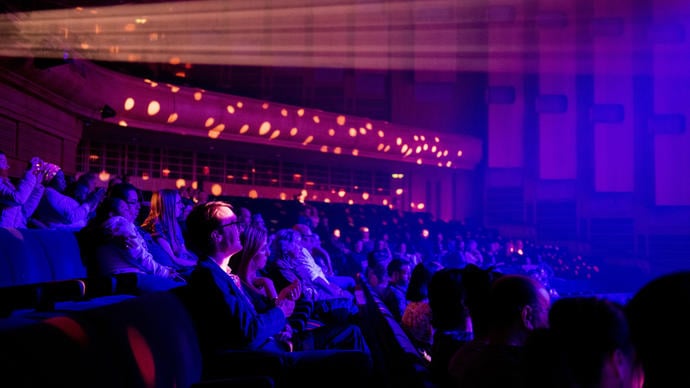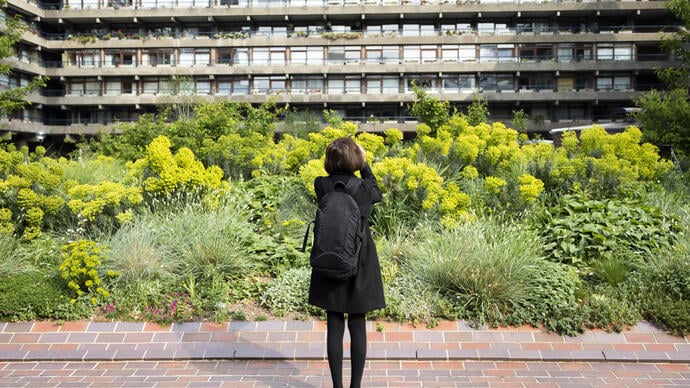Ukrainian Freedom Orchestra/Keri-Lynn Wilson

The Ukrainian Freedom Orchestra today makes its debut at the Barbican; it was founded in response to the invasion by Russia and it proves not only the universality of music as a language, but its power to silence aggression.
A passionate nationalist, Giuseppe Verdi (1813–1901) dreamed of the time when his divided and oppressed Italian homeland would throw off foreign domination and unite as one country. The slogan ‘Viva Verdi!’ became a nationalist rallying cry in the composer’s own lifetime, the letters of his name taken to spell out ‘Vittorio Emanuele, Re D’Italia’ (Vittorio Emanuele, King of Italy), anticipating the time when the then King of Sardinia would ascend the throne of a united Italian nation. But Verdi also knew that the two great themes of Italian grand opera are Love and Death, and his music abounds in both, expressed in gripping theatrical drama and strings of glorious melodies. There’s plenty of both in the overture to the aptly named La forza del destino (‘The Force of Destiny’), which sets the scene for the opera with remarkable economy of means, while also offering a compelling depiction of the action and consequences of pitiless fate.
Yevhen Stankovych (born 1942) wrote his Second Violin Concerto in 2006, at a time when his Ukrainian homeland had achieved its long yearned-for independence from Russia, and a mood of cautious optimism had begun to take hold. But the character of the concerto is dark and anguished, with a sense of foreboding right from the start. Personal grief played a part here – Stankovych had already lost several close friends that year; but those losses had heightened his sense of how vulnerable good things can be, and of how destructive forces are always with us. In his long career, Stankovych had had several run-ins with the Soviet authorities, whose attitude to anything that smelled of Ukrainian nationalism was fiercely paranoid. The Soviet Union may have ceased to exist, but the imperialist attitudes that pervaded its thinking had proved more enduring. Stankovych knew well enough how his newly independent country’s aspirations would be viewed in Moscow.
Working closely with the violinist Dmitry Tkachenko, Stankovych created a concerto in which lyricism may be centre stage, but its a mood that often feels under threat. There are three movements, on a broad slow–fast–slow pattern, but they’re so closely interwoven that the concerto feels more like a single outpouring, sustained by the need to express personal and shared grief. Two folklike themes play a key part in the drama: the melancholic song for clarinets and bassoon that begins the Largo finale, and a rocking, sad, lullaby-like motif in triplets that emerges earlier on and is played by the soloist at the very end, in a fragile pizzicato – human lyrical aspiration survives, but only just.
Just as Verdi’s chorus ‘Va pensiero’, from the opera Nabucco, has become the unofficial national anthem of Italy, so the simple but profoundly eloquent Melody by Myroslav Skoryk (1938–2020) has been adopted as a wordless national hymn in his native Ukraine. It was originally written for flute and piano in 1982, for a Soviet film about the Second World War. The Soviet authorities had wanted to put a negative spin on Ukrainian nationalism, but Skoryk composed with his own people’s harrowing loss in mind, especially the catastrophe of the Holodomor – the famine deliberately engineered by Stalin in the early 1930s, which resulted in the deaths of millions of Ukrainians. For all the obvious intensity of feeling, Melody is remarkably dignified, which only made its effect all the more telling when it was used by President Volodymyr Zelensky in the video accompanying his 2022 address to the United States Congress. Since then it has been played all over the world as gesture of musical solidarity.
The feelings of Ludwig van Beethoven (1770–1827) about Revolutionary France’s military hero Napoleon Bonaparte wavered from the start. At some stage he made the decision to dedicate his Heroic Third Symphony to Napoleon. Then, in 1804, Beethoven heard that Napoleon had proclaimed himself Emperor, and he tore out the dedication in fury. The printed title page stated simply: ‘Sinfonia eroica, composed in memory of a great man’. That ‘in memory’ is very telling. But Beethoven’s belief in the possibility of human beings transforming their political destiny proved more robust, and that belief resounds throughout the Eroica Symphony. The first movement is one of Beethoven’s most truly heroic creations, brilliantly conveying the effect of epic conflict. It ends in triumph – or at least the promise of triumph; which only makes the contrast with the sombre Funeral March that follows all the more extreme. This movement culminates in a depiction of cathartic grief, after which the music almost literally breaks down.
An exhilarating Scherzo, with virtuosic fanfare-like horns in the central Trio section, is followed by an epic set of variations on a skeletal pizzicato figure, heard first in the bass. This stupendously ambitious finale blends elements of Classical variation, sonata form and fugue into a new kind of dynamic super structure which finally grasps the triumph promised in the first movement. Beethoven knew he had achieved something special here. Years later, when asked which was his favourite among his symphonies, he replied without hesitation, ‘The Eroica’.
© Stephen Johnson
Details
Programme and performers
Giuseppe Verdi Overture to La forza del destino
Yevhen Stankovych Violin Concerto No 2
1. Largo
2. Allegro
3. Largo
Myroslav Skoryk Melody
Ludwig van Beethoven Symphony No 3, Eroica
1. Allegro con brio
2. Marcia funebre. Adagio assai
3. Scherzo. Allegro vivace
4. Finale. Allegro molto
Ukrainian Freedom Orchestra
Keri-Lynn Wilson conductor
Valeriy Sokolov violin
Artist biographies
The Ukrainian Freedom Orchestra was formed in 2022 by Canadian-Ukrainian conductor Keri-Lynn Wilson in response to Russia’s invasion of Ukraine. As its Music Director, and working in collaboration with the Metropolitan Opera and the Polish National Opera, she has created an ensemble composed of leading Ukrainian musicians from inside the embattled country, as well as recent refugees and Ukrainian members of European orchestras.
Its explicit mission is to defend Ukraine’s cultural legacy as the country fights for its freedom. The inaugural tour took place in Europe and the US in the summer of 2022 and included performances at the BBC Proms, Edinburgh Festival, Les Choregies d’Orange festival in France and in Berlin, Munich, Hamburg, Dublin, Amsterdam, Warsaw, New York City (Lincoln Center’s Damrosch Park) and the Kennedy Center in Washington DC.
Now under the patronage of Ukraine’s First Lady, Olena Zelenska, the Ukrainian Freedom Orchestra will come together each summer to tour capital cities and festivals of the world. As Ms Zelenska says: ‘The Ukrainian Freedom Orchestra is the musical voice of Ukraine. Universal and understandable without translation, music is a language we can use to speak to the world. Music will speak to silence aggression.’
Keri-Lynn Wilson is the founding conductor and music director of the Ukrainian Freedom Orchestra, an ensemble she helped to form and which is composed of leading Ukrainian musicians from inside the embattled country, as well as recent refugees and Ukrainian members of European orchestras.
Her international career includes working with leading orchestras, such as the Bavarian Radio Symphony Orchestra, Los Angeles Philharmonic, NDR Hanover Orchestra, Prague Philharmonia, Bruckner Linz Orchestra and the NHK, San Francisco, Seattle and Toronto Symphony orchestras.
Operatic highlights include Carmen and La traviata at the Royal Opera House, Covent Garden; her Metropolitan Opera debut, conducting The Lady Macbeth of the Mtsensk District; Tosca, Madama Butterfly and La traviata at the Vienna State Opera; La traviata, Madama Butterfly and The Barber of Seville at the Bavarian State Opera; Madama Butterfly at the Deutsche Oper Berlin; The Lady Macbeth of the Mtsensk District and La traviata at the Zurich Opera House; La fanciulla del West and Aida at English National Opera; Rusalka at Czech National Opera; Rigoletto at Norwegian National Opera; Der Fliegende Holländer, Carmina burana, Boris Godunov and Carmen at Polish National Opera; Faust at Washington National Opera; The Queen of Spades and Tosca at Latvian National Opera; and Madama Butterfly at the Canadian Opera Company.
She was nominated for Conductor of the Year at the Opus Klassik 2020 awards for her recording of Rossini’s Sigismondo with the BRSO.
The Ukrainian violinist Valeriy Sokolov is one of the leading artists of his generation. He works regularly with the world’s leading orchestras, including the Philharmonia Orchestra, Berlin Konzerthausorchester, New Japan, Oslo, Rotterdam, Royal and Seoul Philharmonic orchestras, Chamber Orchestra of Europe, Orchestre de Paris, Cleveland Orchestra, BBC, City of Birmingham, Shanghai and Tokyo Symphony orchestras and Zurich Tonhalle Orchestra.
He frequently works with conductors such as Vladimir Ashkenazy, David Zinman, Susanna Malkki, Andris Nelsons, Charles Dutoit, Cristian Măcelaru, Peter Oundjian, Rafael Payare, Santtu-Matias Rouvali, Yannick Nezet- Seguin, Juraj Valčuha and Kirill Karabits.
He has appeared at many major European festivals, including Lucerne, Verbier and Lockenhaus. He regularly performs at concert halls worldwide, with highlights including regular Sunday Morning series appearances in Theatre du Chatelet, as well as at Wigmore Hall, Lincoln Center, Mariinsky Theatre, Prinzregenten Theatre in Munich and the Vienna Musikverein. As an chamber musician he has collaborated with Gary Hoffman, Gerard Causse, Lisa Batiashvili, Francois Leleux and Nelson Goerner, among others.
He was born in 1986 in Kharkiv, Ukraine, and studied with Natalia Boyarskaya, Felix Andrivesky, Marc Lubotsky, Ana Chumachenko, Boris Kuschnir and Gidon Kremer in London, Hamburg, Frankfurt and Vienna.
Valeriy Sokolov won the 2005 George Enescu International Competition in Bucharest.

Our Patrons and supporters
Find out about our Patrons, who help us keep our programme accessible to everyone and allow us to continue investing in the artists and communities we work with.
Love the arts? Become a Patron to engage more closely with our programme.

Who we are
Meet our management team, our Board and the Trustees of our charitable arm, Barbican Centre Trust.
